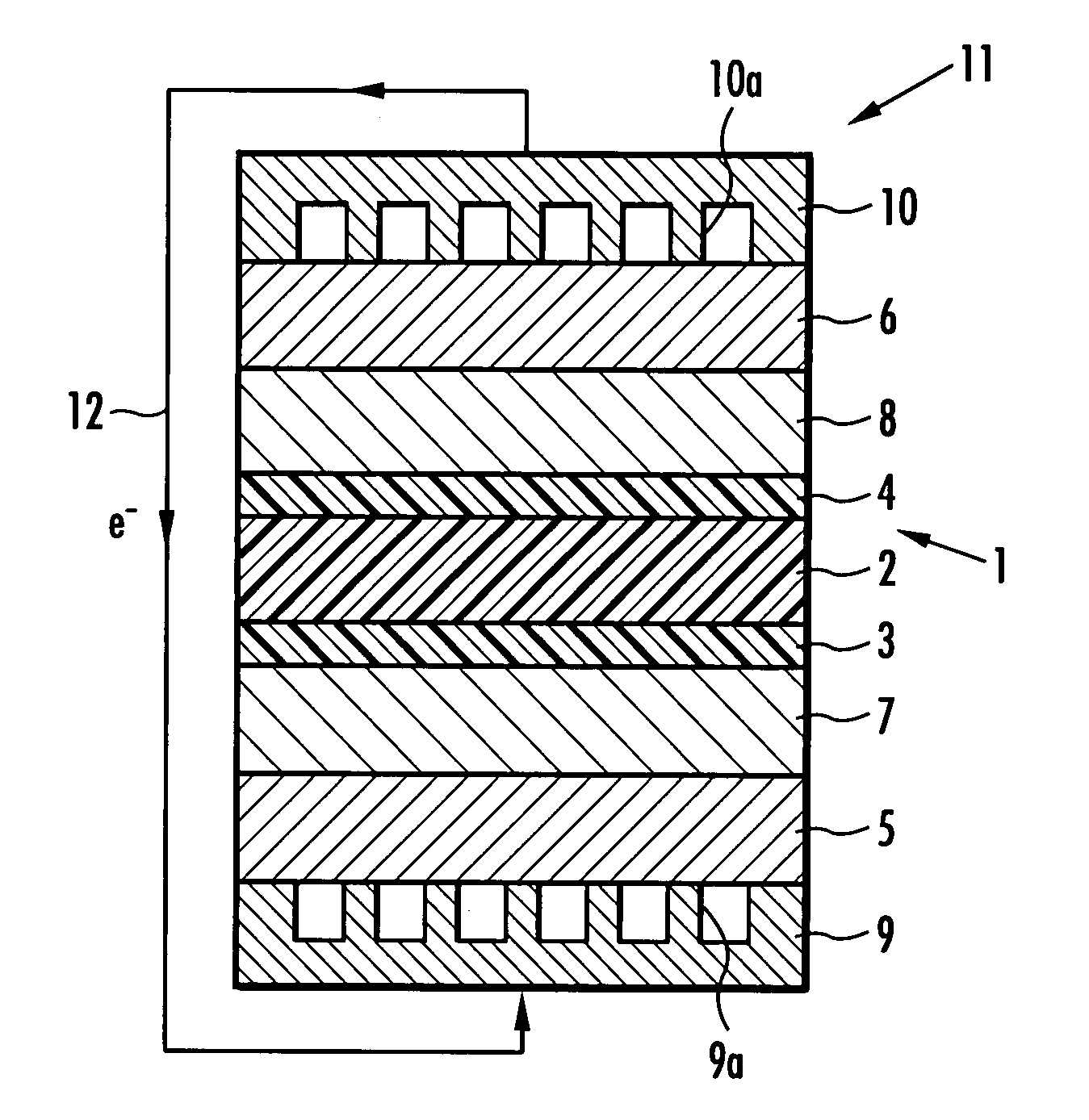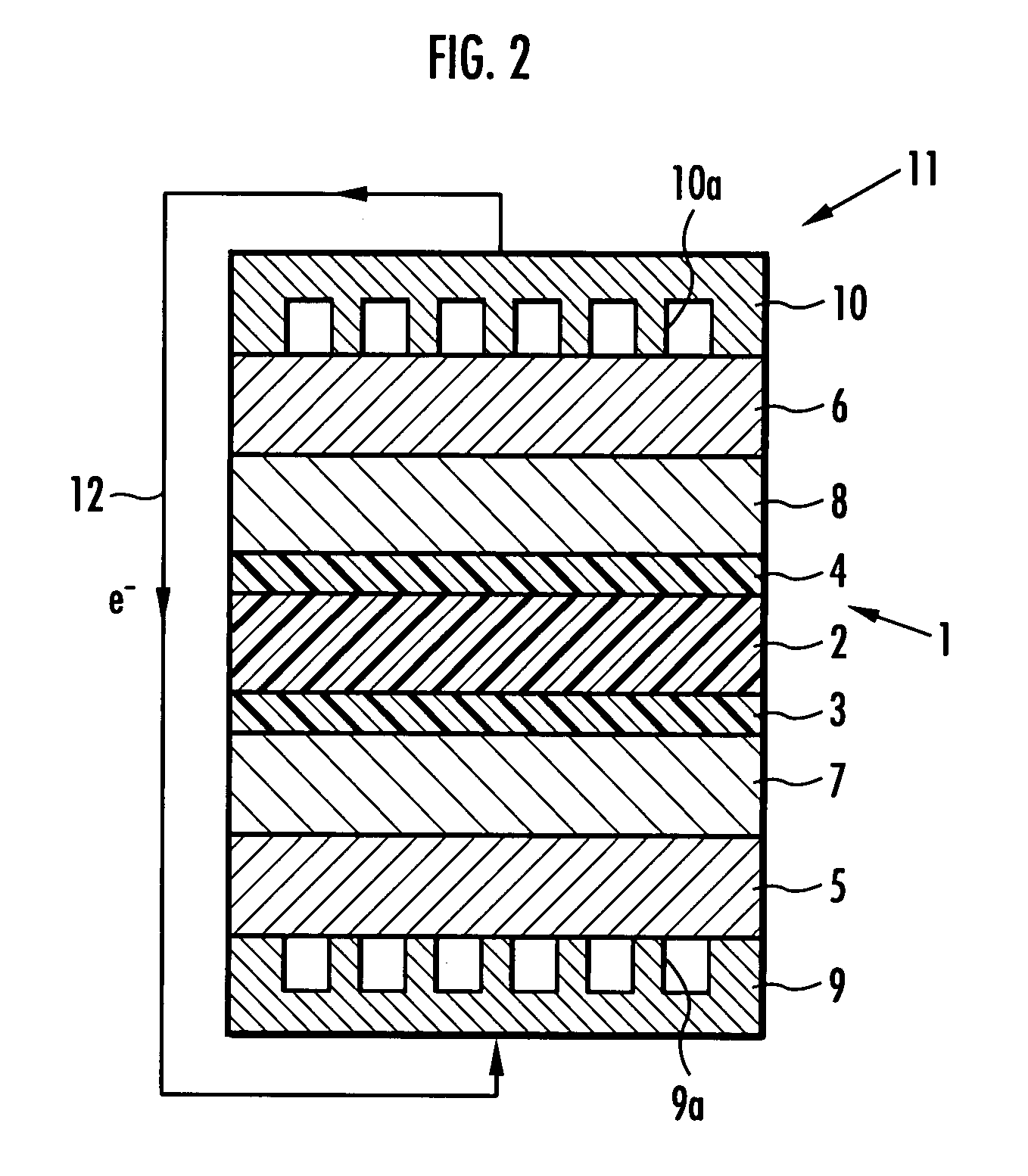Membrane electrode assembly for use in solid polymer electrolyte fuel cell
a solid polymer electrolyte and fuel cell technology, applied in the direction of fuel cell details, cell components, electrochemical generators, etc., can solve the problems of insufficient depletion of resources, and inability to achieve sufficient etc., to ensure gas diffusivity, excellent electric power generation performance, and the ability to discharge the generated water
- Summary
- Abstract
- Description
- Claims
- Application Information
AI Technical Summary
Benefits of technology
Problems solved by technology
Method used
Image
Examples
example 1
[0041]In the present example, at the beginning, the gas diffusion layers 5 and 6 were formed by impregnating a sheet of carbon paper with a 10% by weight solution of tetrafluoroethylene-tetrafluoropropylene copolymer and by thereafter heat treating the impregnated carbon paper at 380° C. for 30 minutes for water-repellent treatment.
[0042]Next, a mixed paste for the cathode intermediate layer was prepared by mixing, under stirring with a three-dimensional stirrer at 1300 rpm for 10 minutes, 10 g of a vapor grown carbon (trademark: VGCF, manufactured by Showa Denko Co., Ltd.) as an electrically conducting agent having pore formability, 10 g of a polytetrafluoroethylene powder (trade name: Fluon L170J, manufactured by Asahi Glass Co., Ltd.) as a water-repellent resin and 220 g of ethylene glycol as a solvent. Then, the mixed paste for the cathode intermediate layer was applied onto the gas diffusion layer 5 in the cathode side by means of screen printing, and thereafter heat treated at...
example 2
[0053]In the present example, a membrane electrode assembly 1 shown in FIG. 1 was fabricated in the same manner as in Example 1 except that a mixture prepared by mixing 7.0 g of a vapor-grown carbon (trademark: VGCF, manufactured by Showa Denko Co., Ltd.) and 3.0 g of a carbon powder (trade name: Vulcan XC-72, manufactured by Cabot Corp.) was used as an electrically conducting agent having pore formability in place of the electrically conducting agent having pore formability used to prepare the mixed paste for the cathode in Example 1.
[0054]The coating amounts (masses) per unit area and the pore volumes of the intermediate layers 7 and 8 were measured in the same manner as in Example 1. The results thus obtained are shown in Table 1.
[0055]The electric power generation performances under high humidity and low humidity of the membrane electrode assembly 1 were evaluated in the same manner as in Example 1. The results thus obtained are shown in Table 2 and FIG. 3.
example 3
[0056]In the present example, a membrane electrode assembly 1 shown in FIG. 1 was fabricated in the same manner as in Example 1 except that a mixture prepared by mixing 10.0 g of a vapor-grown carbon (trademark: VGCF, manufactured by Showa Denko Co., Ltd.) and 1.0 g of a polymethylmethacrylate bead of 5 μm in particle size (trade name: Techpolymer MBX-5, manufactured by Sekisui Plastics Co., Ltd.) as a pore-forming agent was used as an electrically conducting agent having pore formability in place of the electrically conducting agent having pore formability used to prepare the mixed paste for the cathode in Example 1.
[0057]The coating amounts (masses) per unit area and the pore volumes of the intermediate layers 7 and 8 were measured in the same manner as in Example 1. The results thus obtained are shown in Table 1.
[0058]The electric power generation performances under high humidity and low humidity of the membrane electrode assembly 1 were evaluated in the same manner as in Example...
PUM
| Property | Measurement | Unit |
|---|---|---|
| pore size | aaaaa | aaaaa |
| pore size | aaaaa | aaaaa |
| porosity | aaaaa | aaaaa |
Abstract
Description
Claims
Application Information
 Login to View More
Login to View More - R&D
- Intellectual Property
- Life Sciences
- Materials
- Tech Scout
- Unparalleled Data Quality
- Higher Quality Content
- 60% Fewer Hallucinations
Browse by: Latest US Patents, China's latest patents, Technical Efficacy Thesaurus, Application Domain, Technology Topic, Popular Technical Reports.
© 2025 PatSnap. All rights reserved.Legal|Privacy policy|Modern Slavery Act Transparency Statement|Sitemap|About US| Contact US: help@patsnap.com



